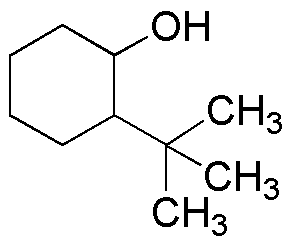2-tert-Butylcyclohexanol is widely utilized in research focused on:
- Solvent Applications: This compound serves as an effective solvent in various chemical reactions, particularly in organic synthesis, enhancing the solubility of reactants and products.
- Flavor and Fragrance Industry: It is used as a flavoring agent and fragrance component, providing a pleasant scent and taste in food products and cosmetics, appealing to consumer preferences.
- Polymer Production: The compound acts as a plasticizer in polymer formulations, improving flexibility and durability in materials such as plastics and rubbers, which is crucial for manufacturing processes.
- Pharmaceuticals: In the pharmaceutical industry, it is explored for its potential as an intermediate in the synthesis of various medicinal compounds, contributing to drug development.
- Research and Development: Researchers utilize it in laboratory settings to study its chemical properties and reactions, aiding in the development of new materials and chemical processes.
General Information
Properties
Safety and Regulations
Applications
2-tert-Butylcyclohexanol is widely utilized in research focused on:
- Solvent Applications: This compound serves as an effective solvent in various chemical reactions, particularly in organic synthesis, enhancing the solubility of reactants and products.
- Flavor and Fragrance Industry: It is used as a flavoring agent and fragrance component, providing a pleasant scent and taste in food products and cosmetics, appealing to consumer preferences.
- Polymer Production: The compound acts as a plasticizer in polymer formulations, improving flexibility and durability in materials such as plastics and rubbers, which is crucial for manufacturing processes.
- Pharmaceuticals: In the pharmaceutical industry, it is explored for its potential as an intermediate in the synthesis of various medicinal compounds, contributing to drug development.
- Research and Development: Researchers utilize it in laboratory settings to study its chemical properties and reactions, aiding in the development of new materials and chemical processes.
Documents
Safety Data Sheets (SDS)
The SDS provides comprehensive safety information on handling, storage, and disposal of the product.
Product Specification (PS)
The PS provides a comprehensive breakdown of the product’s properties, including chemical composition, physical state, purity, and storage requirements. It also details acceptable quality ranges and the product's intended applications.
Certificates of Analysis (COA)
Search for Certificates of Analysis (COA) by entering the products Lot Number. Lot and Batch Numbers can be found on a product’s label following the words ‘Lot’ or ‘Batch’.
Numéro de catalogue
Numéro de lot/série
Certificates Of Origin (COO)
This COO confirms the country where the product was manufactured, and also details the materials and components used in it and whether it is derived from natural, synthetic, or other specific sources. This certificate may be required for customs, trade, and regulatory compliance.
Numéro de catalogue
Numéro de lot/série
Safety Data Sheets (SDS)
The SDS provides comprehensive safety information on handling, storage, and disposal of the product.
DownloadProduct Specification (PS)
The PS provides a comprehensive breakdown of the product’s properties, including chemical composition, physical state, purity, and storage requirements. It also details acceptable quality ranges and the product's intended applications.
DownloadCertificates of Analysis (COA)
Search for Certificates of Analysis (COA) by entering the products Lot Number. Lot and Batch Numbers can be found on a product’s label following the words ‘Lot’ or ‘Batch’.
Numéro de catalogue
Numéro de lot/série
Certificates Of Origin (COO)
This COO confirms the country where the product was manufactured, and also details the materials and components used in it and whether it is derived from natural, synthetic, or other specific sources. This certificate may be required for customs, trade, and regulatory compliance.


